Journal Articles by Michel Destrade

Background
Since their discovery by Karl Langer in the 19th Century, Skin Tension Lines (STLs) h... more Background
Since their discovery by Karl Langer in the 19th Century, Skin Tension Lines (STLs) have been used by surgeons to decide the location and orientation of an incision. Although these lines are patient-specific, most surgeons rely on generic maps to determine their orientation. Beyond the imprecise pinch test, there remains no accepted method for determining STLs in vivo.
Methods
(i) The speed of an elastic motion travelling radially on the skin of canine cadavers was measured with a commercial device called the Reviscometer®. (ii) Similar to the original experiments conducted by Karl Langer, circular excisions were made on the skin and the geometric changes to the resulting wounds and excised samples were used to determine the orientation of STLs.
Results
A marked anisotropy in the speed of the elastic wave travelling radially was observed. The orientation of the fastest wave was found to correlate with the orientation of the elongated wound (P<0.001, R2=74%). Similarly, the orientation of fastest wave was the same for both in vivo and excised isolated samples, indicating that the STLs have a structural basis. Resulting wounds expanded by an average area of 9% (+16% along STL and −10% across) while excised skin shrunk by an average area of 33% (23% along STL and 10% across).
Conclusion
Elastic surface wave propagation has been validated experimentally as a robust method for determining the orientation of STLs non-destructively and non-invasively. This study has implications for the identification of STLs and for the prediction of skin tension levels, both important factors in both human and veterinary reconstructive surgery.
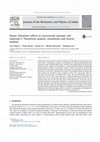
A body force concentrated at a point and moving at a high speed can induce shear-wave Mach cones ... more A body force concentrated at a point and moving at a high speed can induce shear-wave Mach cones in dusty-plasma crystals or soft materials, as observed experimentally and named the elastic Cherenkov effect (ECE). The ECE in soft materials forms the basis of the supersonic shear imaging (SSI) technique, an ultrasound-based dynamic elastography method applied in clinics in recent years. Previous studies on the ECE in soft materials have focused on isotropic material models. In this paper, we investigate the existence and key features of the ECE in anisotropic soft media, by using both theoretical analysis and finite element (FE) simulations, and we apply the results to the non-invasive and nondestructive
characterization of biological soft tissues. We also theoretically study the
characteristics of the shear waves induced in a deformed hyperelastic anisotropic soft material by a source moving with high speed, considering that contact between the ultrasound probe and the soft tissue may lead to finite deformation. On the basis of our theoretical analysis and numerical simulations, we propose an inverse approach to infer both the anisotropic and hyperelastic parameters of incompressible transversely isotropic (TI) soft materials. Finally, we investigate the properties of the solutions to the inverse problem by deriving the condition numbers in analytical form and performing numerical experiments. In Part II of the paper, both ex vivo and in vivo experiments are conducted to demonstrate the applicability of the inverse method in practical use.

The equations governing the appearance of flexural static perturbations at the edge of a semi-inf... more The equations governing the appearance of flexural static perturbations at the edge of a semi-infinite thin elastic isotropic plate, subjected to a state of homogeneous bi-axial pre-stress, are derived and solved. The plate is incompressible and supported
by a Winkler elastic foundation with, possibly, wavenumber dependence. Small perturbations superposed onto the homogeneous state of pre-stress, within the three-dimensional elasticity theory, are considered. A series expansion of the plate kinematics in the plate thickness provides a consistent expression for the second variation of the potential energy, whose minimization gives the plate governing equations. Consistency considerations supplement a constraint on the scaling of the pre-stress so that the classical Kirchhoff–Love linear theory of pre-stretched elastic
plates is retrieved. Moreover, a scaling constraint for the foundation stiffness is also introduced. Edge wrinkling is investigated and compared with body wrinkling. We find that the former always precedes the latter in a state of uni-axial pre-stretch, regardless of the foundation stiffness. By contrast, a general bi-axial pre-stretch state may favour body wrinkling for moderate foundation stiffness. Wavenumber dependence significantly alters the predicted behaviour. The results may be especially relevant to modelling soft biological materials, such as skin or tissues, or stretchable organic thin-films, embedded in a compliant elastic matrix.
We find the strain energy function for isotropic incompressible solids exhibiting a linear relati... more We find the strain energy function for isotropic incompressible solids exhibiting a linear relationship between shear stress and amount of shear, and between torque and amount of twist, when subject to large simple shear or torsion deformations. It is inclusive of the well-known neo-Hookean and the Mooney–Rivlin models, but also can accommodate other terms, as certain arbitrary functions of the principal strain invariants. Effectively, the extra terms can be used to account for several non-linear effects observed experimentally but not captured by the neo-Hookean and Mooney–Rivlin models, such as strain stiffening effects due to limiting chain extensibility.
Living matter can functionally adapt to external physical factors by developing internal tensions... more Living matter can functionally adapt to external physical factors by developing internal tensions, easily revealed by cutting experiments. Nonetheless, residual stresses intrinsically have a complex spatial distribution, and destructive techniques cannot be used to identify a natural stress-free configuration. This work proposes a novel elastic theory of pre-stressed materials. Imposing physical compatibility and symmetry arguments, we define a new class of free energies explicitly depending on the internal stresses. This theory is finally applied to the study of arterial remodelling, proving its potential for the non-destructive determination of the residual tensions within biological materials.
Many interesting shapes appearing in the biological world are formed by the onset of mechanical i... more Many interesting shapes appearing in the biological world are formed by the onset of mechanical instability. In this work we consider how the build-up of residual stress can cause a solid to buckle. In all past studies a fictitious (virtual) stress-free state was required to calculate the residual stress. In contrast, we use a model which is simple and allows the prescription of any residual stress field.
We specialize the analysis to an elastic tube subject to a two-dimensional residual stress, and find that incremental wrinkles can appear on its inner or its outer face, depending on the location of the highest value of the residual hoop stress. We further validate the predictions of the incremental theory with finite element simulations, which allow us to go beyond this threshold and predict the shape, number and amplitude of the resulting creases.

An initial stress within a solid can arise to support external loads or from processes such as th... more An initial stress within a solid can arise to support external loads or from processes such as thermal expansion in inert matter or growth and remodelling in living materials. For this reason, it is useful to develop a mechanical framework of initially stressed solids irrespective of how this stress formed. An ideal way to do this is to write the free energy density Ψ in terms of initial stress τ and the elastic deformation gradient F, so we write Ψ = Ψ (F, τ). In this paper, we present a new constitutive condition for initially stressed materials, which we call the initial stress symmetry (ISS). We focus on two consequences of this condition. First, we examine how ISS restricts the possible choices of free energy densities Ψ = Ψ (F, τ) and present two examples of Ψ that satisfy the ISS. Second, we show that the initial stress can be derived from the Cauchy stress and the elastic deformation gradient. To illustrate, we take an example from biomechanics and calculate the optimal Cauchy stress within an artery subjected to internal pressure. We then use ISS to derive the optimal target residual stress for the material to achieve after remodelling, which links nicely with the notion of homeostasis.
Ray Ogden's work has had a major influence in the broad field of solid mechanics, within the cont... more Ray Ogden's work has had a major influence in the broad field of solid mechanics, within the context of continuum mechanics. It continues to do so as can be checked by looking at the exponential rise of his citation count, totalling according to Google Scholar more than 15,000 to date, with an h-index of 51. Whatever value we attach to bibliometric indicators, these numbers clearly point to a deep and profound impact. Here, instead of presenting the long list of his achievements, awards and publications (to be found elsewhere), we prefer to highlight three of the themes for which his work has received the most attention. Needless to say, the spectrum of his abilities is far wider.
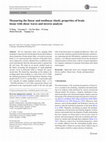
We use supersonic shear wave imaging (SSI) technique to measure not only the linear but also the ... more We use supersonic shear wave imaging (SSI) technique to measure not only the linear but also the nonlinear elastic properties of brain matter. Here, we tested six porcine brains ex vivo and measured the velocities of the plane shear waves induced by acoustic radiation force at different states of pre-deformation when the ultrasonic probe is pushed into the soft tissue. We relied on an inverse method based on the theory governing the propagation of small-amplitude acoustic waves in deformed solids to interpret the experimental data. We found that, depending on the subjects, the resulting initial shear modulus µ 0 varies from 1.8 to 3.2 kPa, the stiffening parameter b of the hyperelastic Demiray–Fung model from 0.13 to 0.73, and the third-(A) and fourth-order (D) constants of weakly nonlinear elasticity from −1.3 to −20.6 kPa and from 3.1 to 8.7 kPa, respectively. Paired t test performed on the experimental results of the left and right Yi Jiang and Guoyang Li have contributed equally to this study. lobes of the brain shows no significant difference. These values are in line with those reported in the literature on brain tis-sue, indicating that the SSI method, combined to the inverse analysis, is an efficient and powerful tool for the mechanical characterization of brain tissue, which is of great importance for computer simulation of traumatic brain injury and virtual neurosurgery.
We show that porcine brain matter can be modelled accurately as a very soft rubber-like material ... more We show that porcine brain matter can be modelled accurately as a very soft rubber-like material using the Mooney-Rivlin strain energy function, up to strains as high as 60%. This result followed from simple shear experiments performed on small rectangular fresh samples (2.5 cm^3 and 1.1 cm^3) at quasi-static strain rates. They revealed a linear shear stress-shear strain relationship (R^2>0.97), characteristic of Mooney-Rivlin materials at large strains. We found that porcine brain matter is about 30 times less resistant to shear forces than a silicone gel. We also verified experimentally that brain matter exhibits the positive Poynting effect of non-linear elasticity, and numerically that the stress and strain fields remain mostly homogeneous throughout the thickness of the samples in simple shear.
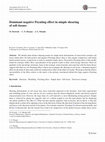
We identify three distinct shearing modes for simple shear deformations of transversely isotropic... more We identify three distinct shearing modes for simple shear deformations of transversely isotropic soft tissue which allow for both positive and negative Poynting effects (that is, they require compressive and tensile lateral normal stresses, respectively, in order to maintain simple shear). The positive Poynting effect is that usually found for isotropic rubber. Here, specialisation of the general results to three strain-energy functions which are quadratic in the anisotropic invariants, linear in the isotropic strain invariants and consistent with the linear theory suggests that there are two Poynting effects which can accompany the shearing of soft tissue: a dominant negative effect in one mode of shear and a relatively small positive effect in the other two modes. We propose that the relative inextensibility of the fibres relative to the matrix is the primary mechanism behind this large negative Poynting effect.
We revisit an iconic deformation of non-linear elasticity: the inflation of a rubber spherical th... more We revisit an iconic deformation of non-linear elasticity: the inflation of a rubber spherical thin shell. We use the 3-parameter Mooney and Gent-Gent (GG) phenomenological models to explain the stretch–strain curve of a typical inflation, as these two models cover a wide spectrum of known models for rubber, including the Varga, Mooney–Rivlin, one-term Ogden, Gent-Thomas and Gent models. We find that the basic physics of inflation exclude the Varga, one-term Ogden and Gent-Thomas models. We find the link between the exact solution of non-linear elasticity and the membrane and Young–Laplace theories often used a priori in the literature. We compare the performance of both models on fitting the data for experiments on rubber balloons and animal bladder. We conclude that the GG model is the most accurate and versatile model on offer for the modelling of rubber balloon inflation.
Collaborative research between the disciplines of forensic pathology and biomechanics was underta... more Collaborative research between the disciplines of forensic pathology and biomechanics was undertaken to investigate the hyperelastic properties of human skin, to determine the force required for sharp instrument penetration of skin, and to develop a finite element model, which reflects the mechanisms of sharp instrument penetration. These studies have led to the development of a “stab metric,” based on simulations, to describe the force magnitudes in stabbing incidents. Such a metric should, in time, replace the crudely quantitative descriptors of stabbing forces currently used by forensic pathologists.

The Holzapfel–Gasser–Ogden (HGO) model for anisotropic hyperelastic behaviour of collagen fibre r... more The Holzapfel–Gasser–Ogden (HGO) model for anisotropic hyperelastic behaviour of collagen fibre reinforced materials was initially developed to describe the elastic properties of arterial tissue, but is now used extensively for modelling a variety of soft biological tissues. Such materials can be regarded as incompressible, and when the incompressibility condition is adopted the strain energy Ψ of the HGO model is a function of one isotropic and two anisotropic deformation invariants. A compressible form (HGO-C model) is widely used in finite element simulations whereby the isotropic part of Ψ is decoupled into volumetric and isochoric parts and the anisotropic part of Ψ is expressed in terms of isochoric invariants. Here, by using three simple deformations (pure dilatation, pure shear and uniaxial stretch), we demonstrate that the compressible HGO-C formulation does not correctly model compressible anisotropic material behaviour, because the anisotropic component of the model is insensitive to volumetric deformation due to the use of isochoric anisotropic invariants. In order to correctly model compressible anisotropic behaviour we present a modified anisotropic (MA) model, whereby the full anisotropic invariants are used, so that a volumetric anisotropic contribution is represented. The MA model correctly predicts an anisotropic response to hydrostatic tensile loading, whereby a sphere deforms into an ellipsoid. It also computes the correct anisotropic stress state for pure shear and uniaxial deformations. To look at more practical applications, we developed a finite element user-defined material subroutine for the simulation of stent deployment in a slightly compressible artery. Significantly higher stress triaxiality and arterial compliance are computed when the full anisotropic invariants are used (MA model) instead of the isochoric form (HGO-C model).
One of the least studied universal deformations of incompressible nonlinear elasticity, namely th... more One of the least studied universal deformations of incompressible nonlinear elasticity, namely the straightening of a sector of a circular cylinder into a rectangular block, is revisited here and, in particular, issues of existence and stability are addressed. Particular attention is paid to the system of forces required to sustain the large static deformation, including by the application of end couples. The influence of geometric parameters and constitutive models on the appearance of wrinkles on the compressed face of the block is also studied. Different numerical methods for solving the incremental stability problem are compared and it is found that the impedance matrix method, based on the resolution of a matrix Riccati differential equation, is the more precise.
Journal of the Mechanics and Physics of Solids
We consider the elastic deformation of a circular cylindrical sector composed of an incompressibl... more We consider the elastic deformation of a circular cylindrical sector composed of an incompressible isotropic soft solid when it is straightened into a rectangular block. In this process, the circumferential line elements on the original inner face of the sector are stretched while those on the original outer face are contracted. We investigate the geometrical and physical conditions under which the latter line elements can be contracted to the point where a localized incremental instability develops. We provide a robust algorithm to solve the corresponding two-point boundary value problem, which is stiff numerically. We illustrate the results with full incremental displacement fields in the case of Mooney–Rivlin materials and also perform an asymptotic analysis for thin sectors.
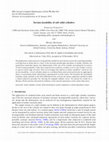
The application of pure torsion to a long and thin cylindrical rod is known to provoke a twisting... more The application of pure torsion to a long and thin cylindrical rod is known to provoke a twisting instability, evolving from an initial kink to a knot. In the torsional parallel-plate rheometry of stubby cylinders, the geometrical constraints impose zero displacement of the axis of the cylinder, preventing the occurrence of such twisting instability. Under these experimental conditions, wrinkles occur on the cylinder’s surface at a given critical angle of torsion. Here we investigate this subclass of elastic instability—which we call torsion instability—of soft cylinders subject to a combined finite axial stretch and torsion, by applying the theory of incremental elastic deformation superimposed on finite strains. We formulate the incremental boundary elastic problem in the Stroh differential form, and use the surface impedance method to build a robust numerical procedure for deriving the marginal stability curves. We present the results for a Mooney–Rivlin material and study the influence of the material parameters on the elastic bifurcation.
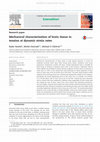
Mechanical characterization of brain tissue at high loading velocities is crucial for modeling Tr... more Mechanical characterization of brain tissue at high loading velocities is crucial for modeling Traumatic Brain Injury (TBI). During severe impact conditions, brain tissue experiences compression, tension and shear. Limited experimental data is available for brain tissue in extension at dynamic strain rates. In this research, a High Rate Tension Device (HRTD) was developed to obtain dynamic properties of brain tissue in extension at strain rates of ≤90/s. In vitro tensile tests were performed to obtain properties of brain tissue at strain rates of 30, 60 and 90/s up to 30% strain. The brain tissue showed a stiffer response with increasing strain rates, showing that hyperelastic models are not adequate. Specifically, the tensile engineering stress at 30% strain was 3.1±0.49 kPa, 4.3±0.86 kPa, 6.5±0.76 kPa (mean±SD) at strain rates of 30, 60 and 90/s, respectively. Force relaxation tests in tension were also conducted at different strain magnitudes (10–60% strain) with the average rise time of 24 ms, which were used to derive time dependent parameters. One-term Ogden, Fung and Gent models were used to obtain material parameters from the experimental data. Numerical simulations were performed using a one-term Ogden model to analyze hyperelastic behavior of brain tissue up to 30% strain. The material parameters obtained in this study will help to develop biofidelic human brain finite element models, which can subsequently be used to predict brain injuries under impact conditions and as a reconstruction and simulation tool for forensic investigations.

During severe impact conditions, brain tissue experiences a rapid and complex deformation, which ... more During severe impact conditions, brain tissue experiences a rapid and complex deformation, which can be seen as a mixture of compression, tension and shear. Diffuse axonal injury (DAI) occurs in animals and humans when both the strains and strain rates exceed 10% and 10/s, respectively. Knowing the mechanical properties of brain tissue in shear at these strains and strain rates is thus of particular importance, as they can be used in finite element simulations to predict the occurrence of brain injuries under different impact conditions. However, very few studies in the literature provide this information. In this research, an experimental setup was developed to perform simple shear tests on porcine brain tissue at strain rates ≤120/s. The maximum measured shear stress at strain rates of 30, 60, 90 and 120/s was 1.15±0.25 kPa, 1.34±0.19 kPa, 2.19±0.225 kPa and 2.52±0.27 kPa, (mean±SD), respectively at the maximum amount of shear, K=1. Good agreement of experimental, theoretical (Ogden and Mooney–Rivlin models) and numerical shear stresses was achieved (p=0.7866–0.9935). Specimen thickness effects (2.0–10.0 mm thick specimens) were also analyzed numerically and we found that there is no significant difference (p=0.9954) in the shear stress magnitudes, indicating a homogeneous deformation of the specimens during simple shear tests. Stress relaxation tests in simple shear were also conducted at different strain magnitudes (10–60% strain) with the average rise time of 14 ms. This allowed us to estimate elastic and viscoelastic parameters (initial shear modulus, μ=4942.0 Pa, and Prony parameters: g1=0.520, g2=0.3057, τ1=0.0264 s, and τ2=0.011 s) that can be used in FE software to analyze the non-linear viscoelastic behavior of brain tissue. This study provides new insight into the behavior in finite shear of brain tissue under dynamic impact conditions, which will assist in developing effective brain injury criteria and adopting efficient countermeasures against traumatic brain injury.
Keywords
Diffuse axonal injury (DAI); Ogden; Mooney–Rivlin; Traumatic brain injury (TBI); Homogeneous; Viscoelastic; Relaxation
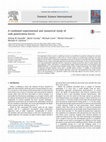
The magnitude of force used in a stabbing incident can be difficult to quantify, although the est... more The magnitude of force used in a stabbing incident can be difficult to quantify, although the estimate given by forensic pathologists is often seen as ‘critical’ evidence in medico-legal situations. The main objective of this study is to develop a quantitative measure of the force associated with a knife stabbing biological tissue, using a combined experimental and numerical technique. A series of stab-penetration tests were performed to quantify the force required for a blade to penetrate skin at various speeds and using different ‘sharp’ instruments. A computational model of blade penetration was developed using ABAQUS/EXPLICIT, a non-linear finite element analysis (FEA) commercial package. This model, which incorporated element deletion along with a suitable failure criterion, is capable of systematically quantifying the effect of the many variables affecting a stab event. This quantitative data could, in time, lead to the development of a predictive model that could help indicate the level of force used in a particular stabbing incident.
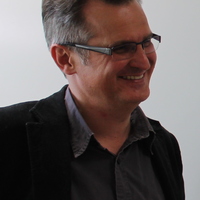







Uploads
Journal Articles by Michel Destrade
Since their discovery by Karl Langer in the 19th Century, Skin Tension Lines (STLs) have been used by surgeons to decide the location and orientation of an incision. Although these lines are patient-specific, most surgeons rely on generic maps to determine their orientation. Beyond the imprecise pinch test, there remains no accepted method for determining STLs in vivo.
Methods
(i) The speed of an elastic motion travelling radially on the skin of canine cadavers was measured with a commercial device called the Reviscometer®. (ii) Similar to the original experiments conducted by Karl Langer, circular excisions were made on the skin and the geometric changes to the resulting wounds and excised samples were used to determine the orientation of STLs.
Results
A marked anisotropy in the speed of the elastic wave travelling radially was observed. The orientation of the fastest wave was found to correlate with the orientation of the elongated wound (P<0.001, R2=74%). Similarly, the orientation of fastest wave was the same for both in vivo and excised isolated samples, indicating that the STLs have a structural basis. Resulting wounds expanded by an average area of 9% (+16% along STL and −10% across) while excised skin shrunk by an average area of 33% (23% along STL and 10% across).
Conclusion
Elastic surface wave propagation has been validated experimentally as a robust method for determining the orientation of STLs non-destructively and non-invasively. This study has implications for the identification of STLs and for the prediction of skin tension levels, both important factors in both human and veterinary reconstructive surgery.
characterization of biological soft tissues. We also theoretically study the
characteristics of the shear waves induced in a deformed hyperelastic anisotropic soft material by a source moving with high speed, considering that contact between the ultrasound probe and the soft tissue may lead to finite deformation. On the basis of our theoretical analysis and numerical simulations, we propose an inverse approach to infer both the anisotropic and hyperelastic parameters of incompressible transversely isotropic (TI) soft materials. Finally, we investigate the properties of the solutions to the inverse problem by deriving the condition numbers in analytical form and performing numerical experiments. In Part II of the paper, both ex vivo and in vivo experiments are conducted to demonstrate the applicability of the inverse method in practical use.
by a Winkler elastic foundation with, possibly, wavenumber dependence. Small perturbations superposed onto the homogeneous state of pre-stress, within the three-dimensional elasticity theory, are considered. A series expansion of the plate kinematics in the plate thickness provides a consistent expression for the second variation of the potential energy, whose minimization gives the plate governing equations. Consistency considerations supplement a constraint on the scaling of the pre-stress so that the classical Kirchhoff–Love linear theory of pre-stretched elastic
plates is retrieved. Moreover, a scaling constraint for the foundation stiffness is also introduced. Edge wrinkling is investigated and compared with body wrinkling. We find that the former always precedes the latter in a state of uni-axial pre-stretch, regardless of the foundation stiffness. By contrast, a general bi-axial pre-stretch state may favour body wrinkling for moderate foundation stiffness. Wavenumber dependence significantly alters the predicted behaviour. The results may be especially relevant to modelling soft biological materials, such as skin or tissues, or stretchable organic thin-films, embedded in a compliant elastic matrix.
We specialize the analysis to an elastic tube subject to a two-dimensional residual stress, and find that incremental wrinkles can appear on its inner or its outer face, depending on the location of the highest value of the residual hoop stress. We further validate the predictions of the incremental theory with finite element simulations, which allow us to go beyond this threshold and predict the shape, number and amplitude of the resulting creases.
Keywords
Diffuse axonal injury (DAI); Ogden; Mooney–Rivlin; Traumatic brain injury (TBI); Homogeneous; Viscoelastic; Relaxation
Since their discovery by Karl Langer in the 19th Century, Skin Tension Lines (STLs) have been used by surgeons to decide the location and orientation of an incision. Although these lines are patient-specific, most surgeons rely on generic maps to determine their orientation. Beyond the imprecise pinch test, there remains no accepted method for determining STLs in vivo.
Methods
(i) The speed of an elastic motion travelling radially on the skin of canine cadavers was measured with a commercial device called the Reviscometer®. (ii) Similar to the original experiments conducted by Karl Langer, circular excisions were made on the skin and the geometric changes to the resulting wounds and excised samples were used to determine the orientation of STLs.
Results
A marked anisotropy in the speed of the elastic wave travelling radially was observed. The orientation of the fastest wave was found to correlate with the orientation of the elongated wound (P<0.001, R2=74%). Similarly, the orientation of fastest wave was the same for both in vivo and excised isolated samples, indicating that the STLs have a structural basis. Resulting wounds expanded by an average area of 9% (+16% along STL and −10% across) while excised skin shrunk by an average area of 33% (23% along STL and 10% across).
Conclusion
Elastic surface wave propagation has been validated experimentally as a robust method for determining the orientation of STLs non-destructively and non-invasively. This study has implications for the identification of STLs and for the prediction of skin tension levels, both important factors in both human and veterinary reconstructive surgery.
characterization of biological soft tissues. We also theoretically study the
characteristics of the shear waves induced in a deformed hyperelastic anisotropic soft material by a source moving with high speed, considering that contact between the ultrasound probe and the soft tissue may lead to finite deformation. On the basis of our theoretical analysis and numerical simulations, we propose an inverse approach to infer both the anisotropic and hyperelastic parameters of incompressible transversely isotropic (TI) soft materials. Finally, we investigate the properties of the solutions to the inverse problem by deriving the condition numbers in analytical form and performing numerical experiments. In Part II of the paper, both ex vivo and in vivo experiments are conducted to demonstrate the applicability of the inverse method in practical use.
by a Winkler elastic foundation with, possibly, wavenumber dependence. Small perturbations superposed onto the homogeneous state of pre-stress, within the three-dimensional elasticity theory, are considered. A series expansion of the plate kinematics in the plate thickness provides a consistent expression for the second variation of the potential energy, whose minimization gives the plate governing equations. Consistency considerations supplement a constraint on the scaling of the pre-stress so that the classical Kirchhoff–Love linear theory of pre-stretched elastic
plates is retrieved. Moreover, a scaling constraint for the foundation stiffness is also introduced. Edge wrinkling is investigated and compared with body wrinkling. We find that the former always precedes the latter in a state of uni-axial pre-stretch, regardless of the foundation stiffness. By contrast, a general bi-axial pre-stretch state may favour body wrinkling for moderate foundation stiffness. Wavenumber dependence significantly alters the predicted behaviour. The results may be especially relevant to modelling soft biological materials, such as skin or tissues, or stretchable organic thin-films, embedded in a compliant elastic matrix.
We specialize the analysis to an elastic tube subject to a two-dimensional residual stress, and find that incremental wrinkles can appear on its inner or its outer face, depending on the location of the highest value of the residual hoop stress. We further validate the predictions of the incremental theory with finite element simulations, which allow us to go beyond this threshold and predict the shape, number and amplitude of the resulting creases.
Keywords
Diffuse axonal injury (DAI); Ogden; Mooney–Rivlin; Traumatic brain injury (TBI); Homogeneous; Viscoelastic; Relaxation
Keywords: linear elastodynamics, anisotropy, plane homogeneous waves, bulk waves, interface waves, surface waves.